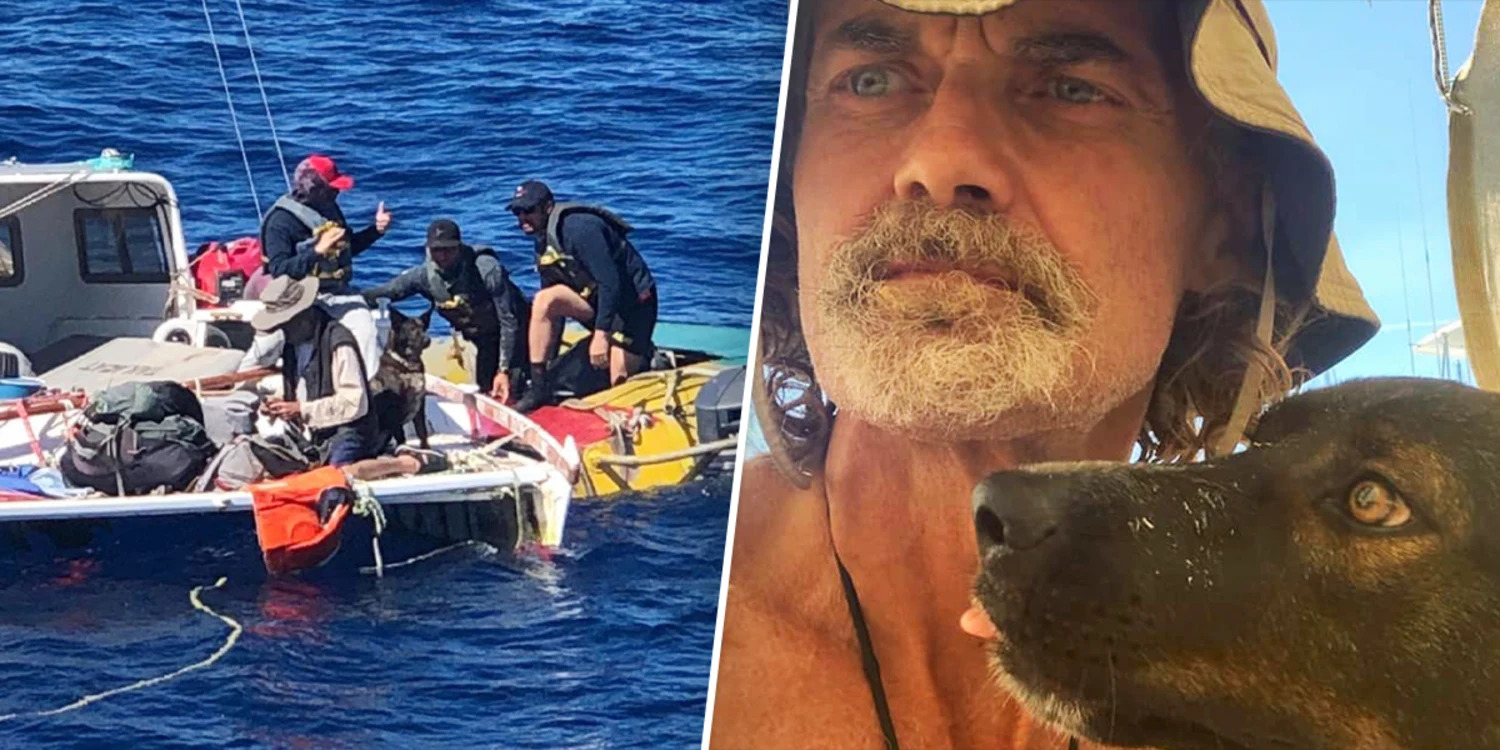Man And Dog Rescued Found After 3 Months Lost At Sea, The Real-Life Castaway
In a remarkable tale of survival reminiscent of the movie "Cast Away," Tim Shaddock and his loyal dog, Bella. Both the man and dog rescued found after 3 months lost at sea. Departing from La Paz in Mexico on a voyage to French Polynesia, Shaddock's catamaran encountered treacherous storms, damaging the boat's electronics and cutting off all communications. Left with no means of contact, Shaddock and Bella faced an arduous journey, relying on their resourcefulness and determination to stay alive.
Author:Morgan MaverickReviewer:Professor JhizJul 18, 202317 Shares16.9K Views

In a remarkable tale of survival reminiscent of the movie "Cast Away," Tim Shaddock and his loyal dog, Bella. Both the man and dog rescued found after 3 months lost at sea. Departing from La Paz in Mexico on a voyage to French Polynesia, Shaddock's catamaran encountered treacherous storms, damaging the boat's electronics and cutting off all communications. Left with no means of contact, Shaddock and Bella faced an arduous journey, relying on their resourcefulness and determination to stay alive.
Man And Dog Rescued Found After 3 Months Lost At Sea
With no other human presence in sight, Shaddock and Bella relied on their instincts and survival skills to endure the harsh conditions. They sustained themselves on raw fish and rainwater, utilizing the boat's shelter to shield themselves from the scorching sun. Their resilience and adaptability in the face of adversity were truly remarkable.
Fortunately, their ordeal came to an end when they were spotted by a tuna trawler and its accompanying helicopter. Despite their gaunt appearance and overgrown beards, both Shaddock and Bella miraculously emerged from their harrowing experience without major injuries or illnesses. The sight of their rescue brought relief and hope to all involved.
Upon being found, Shaddock expressed his gratitude, saying:
“„I have been through a very difficult ordeal at sea. I'm just needing rest and good food because I have been alone at sea for a long time. Otherwise, I'm in very good health. I have very good medicine, and I'm being looked after very well.- Tim Shaddock
His immediate priority was to rest and nourish himself after enduring the solitude and challenges of being adrift at sea.
Shaddock and Bella are currently being transported back to Mexico by the tuna trawler, where they will receive further medical treatment and care. Their incredible story of survival serves as a reminder of the indomitable human spirit and the deep bond between man and animal.
This is not the first time a family has experienced the challenges of being stranded at sea. Decades ago, the Robertson family embarked on a voyage around the world. After a year and a half, their boat sank due to a killer whale attack. Stranded on a life raft and fiberglass dinghy with limited supplies, including only enough water for 10 days and three days of emergency food rations, the family faced a grueling test of endurance.

“Luck and skill’: Sailor and dog survive three months lost at sea | 9 News Australia
With resilience and ingenuity, the Robertson family survived by fishing and consuming turtles' blood. After 38 days, their remarkable saga reached a turning point when they were rescued by a Japanese fishing trawler. Their story, like Shaddock's, highlights the strength of the human spirit and the will to survive against all odds.
The tales of Tim Shaddock, the Robertson family, and countless others remind us of the inherent bravery and resilience that can emerge in the face of adversity. These stories captivate our imagination, providing a glimpse into the extraordinary capabilities of individuals when confronted with the harshest of circumstances.
Vital Strategies For Survival At Sea
The man and dog rescued found after 3 months lost at sea survived because of instincts and survival skills. The vast and unforgiving expanse of the open sea presents formidable challenges for those who find themselves stranded or adrift.
However, with the right knowledge and skills, it is possible to navigate these perilous waters and increase the chances of survival. In case you get stranded at sea, here are some vital tips you can take with you for a safe return.
Ensure A Sustainable Water Supply
When stranded at sea, securing a source of drinking water is paramount for survival. Collecting and purifying water can be achieved through resourcefulness and careful planning. One effective method is to utilize a plastic tarpaulin or fabric to catch rainwater, ensuring that the first drops wash away salt residue.
If rainwater is unavailable, seek alternative sources such as dew or moisture on the surface of objects. Remember to avoid consuming saltwater, as it exacerbates dehydration and can be detrimental to your health.
Harness The Power Of Improvisation
Resourcefulness is a key attribute when facing the challenges of survival at sea. In dire situations, improvisation can make a crucial difference. If you are fortunate enough to have sails or other fabric materials, they can be fashioned into a makeshift bowl or container to capture rainwater.
Look for any available objects, such as bottles or cans, to store water. Furthermore, the ability to adapt and repurpose items found in your surroundings can significantly increase your chances of survival.
Navigate By The Celestial Bodies

Navigating by the Stars: Introduction to Celestial Navigation | Sailing Wisdom
Without the aid of modern navigation tools, knowing how to utilize celestial bodies for orientation is a valuable skill. Familiarize yourself with prominent stars and constellations that can serve as reference points.
Polaris, also known as the North Star, can be located by tracing a line through the stars at the end of the Big Dipper's "bowl" and extending it five times its length. Understanding how to navigate using the stars can help you maintain a sense of direction and course when all other references are lost.
The Southern Hemisphere Navigation
For those navigating in the Southern Hemisphere, orienting oneself can be achieved by identifying prominent constellations unique to the region. The Southern Cross serves as a vital marker, and by extending a line down four and a half times the length of its long axis, you can determine the approximate location of the South Pole.
Additionally, recognizing other bright stars, such as Rigil Kent and Hadar, relative to the Southern Cross can aid in determining your position in the southern regions of the globe.
Leveraging The Bounty Of The Ocean
The vast ocean offers potential sources of sustenance when stranded at sea. Take advantage of the ecosystem by employing various fishing techniques. If in a life raft, small fish often gather beneath it, seeking shelter or following floating debris.
Utilize a hand line with a hook and lure to attract fish. Be cautious not to damage the raft when casting the line. Once you catch a fish, utilize the remains as bait to increase your chances of catching additional fish. Embrace the opportunities that the ocean provides to sustain yourself.
Minimizing The Risk Of Shark Encounters
While shark encounters at sea can be intimidating, understanding their behavior and taking preventative measures can mitigate the risk of attacks. Recognize that most shark threats occur in shallower waters and near food sources, such as coral reefs. Prior to entering the water, be aware of potential shark risks and dive with at least one partner, as sharks are less likely to approach groups.
If you encounter a shark, calmly and smoothly swim away, avoiding any sudden movements that may attract its attention. In extreme cases, thrusting objects toward the shark's sensitive areas, such as the nose, eyes, or gills, may deter an attack. Consider submerging to the seafloor and waiting for the shark to leave, as this has proven successful for some divers.
Managing Capsized Boats
Capsizing presents a significant challenge, but knowing how to handle such a situation is crucial. Small sailboats can be easily righted by crawling onto the overturned hull, grabbing the centerboard, and using your weight as leverage to flip the boat back over. Once upright, climb aboard and bail out any water.
Motorboats without a centerboard require a different approach. Tether a rope to a fixed point within the boat, and while facing the side where the rope is tied, crawl onto the hull and lean back to leverage your weight in pulling the boat upright. Once successfully righted, promptly remove water from the boat.
Fire Safety On The Water
A fire on a boat is a serious threat that requires immediate action. Prior to embarking, ensure that fire extinguishers are strategically placed near potential fire sources, such as the galley and engine compartment.
In the event of a fire, evacuate the cabin and ensure everyone wears life vests. Report the emergency on the appropriate channel and prepare for potential abandonment. Fightthe fire with extinguishers, always maintaining a clear escape route. Prioritize extinguishing the fire from the bottom up, as this can help prevent its spread.
Addressing Leaks And Hull Damage
Water intrusion through leaks or hull damage can be a critical issue for survival. Identifying and addressing leaks promptly is vital to maintain the integrity of your vessel. Begin by locating the source of the leak; if it proves elusive, prioritize reaching dry land as quickly as possible.
Check that the boat's drain plug is secure, as an open drain plug may be the cause of the problem. For failed through-hull fittings, temporarily seal the leak with a conical soft-wood plug, ensuring it is tethered to the hull. In the case of a fractured hull, applying a large plastic sheet to cover the leak from the outside and securing it with ropes can help minimize water ingress.
Exercise caution and seek land as soon as possible while relying on the pressure of the water to hold the plastic sheet in place. For minor cracks, duct tape can serve as a temporary solution until proper repairs can be made.

8 GREAT TIPS FOR SURVIVAL AT SEA
By familiarizing yourself with these vital survival strategies, you enhance your chances of overcoming the challenges of being lost or stranded at sea. Remember that adaptability, resourcefulness, and the will to persevere are critical components of survival.
Equip yourself with knowledge, practice essential skills, and face the unpredictable nature of the open sea with confidence. With these strategies at your disposal, you increase the likelihood of a safe return to shore, emerging victorious from the unforgiving grasp of the open ocean.
People Also Ask
How Long Can You Survive Lost At Sea?
In warm waters with proper gear like a wetsuit and life vest, survival can last around three to five days, with dehydration being the main risk.
The First Rule Of Ocean Survival
The first rule is to prioritize protection from the elements, followed by finding sources of water and food. Additionally, preparing signaling methods can increase the chances of being spotted by passing ships or rescuers.
The Most Important Things To Have When Lost At Sea
The essential items to have when lost at sea are personal flotation devices (life vests), sound-producing devices, a personal beacon, and a well-documented float plan. These items can significantly increase your chances of survival and being located by potential rescuers.
Conclusion
In a miraculous rescue, a man and dog rescued found after 3 months lost at sea. Their survival underscores the importance of vital survival tips in navigating such extreme circumstances. From finding water to celestial navigation and addressing leaks, these essential skills can make all the difference when facing the perils of the open ocean. Their incredible story showcases the resilience and preparedness needed to overcome the toughest challenges at sea.

Morgan Maverick
Author
Morgan Maverick is an unorthodox news reporter driven by an insatiable hunger for the truth. Fearless and unconventional, he uncovers hidden narratives that lie beneath the surface, transforming each news piece into a masterpiece of gritty authenticity. With a dedication that goes beyond the boundaries of conventional journalism, Morgan fearlessly explores the fringes of society, giving voice to the marginalized and shedding light on the darkest corners.
His raw and unfiltered reporting style challenges established norms, capturing the essence of humanity in its rawest form. Morgan Maverick stands as a beacon of truth, fearlessly pushing boundaries and inspiring others to question, dig deeper, and recognize the transformative power of journalism.

Professor Jhiz
Reviewer
Professor Jhiz brings fun to teaching anatomy. Born in China, she shares her fascination for how the body works.
Students say her lectures are lively with jokes and stories. She draws cartoon diagrams that highlight structures creatively.
Professor seeks to inspire curiosity and joy in anatomy. She treats each class like a show using props and costumes.
When not teaching, Jhiz enjoys karaoke and novelty socks. Her goal is passing on a spirit of wonder to students.
Latest Articles
Popular Articles
